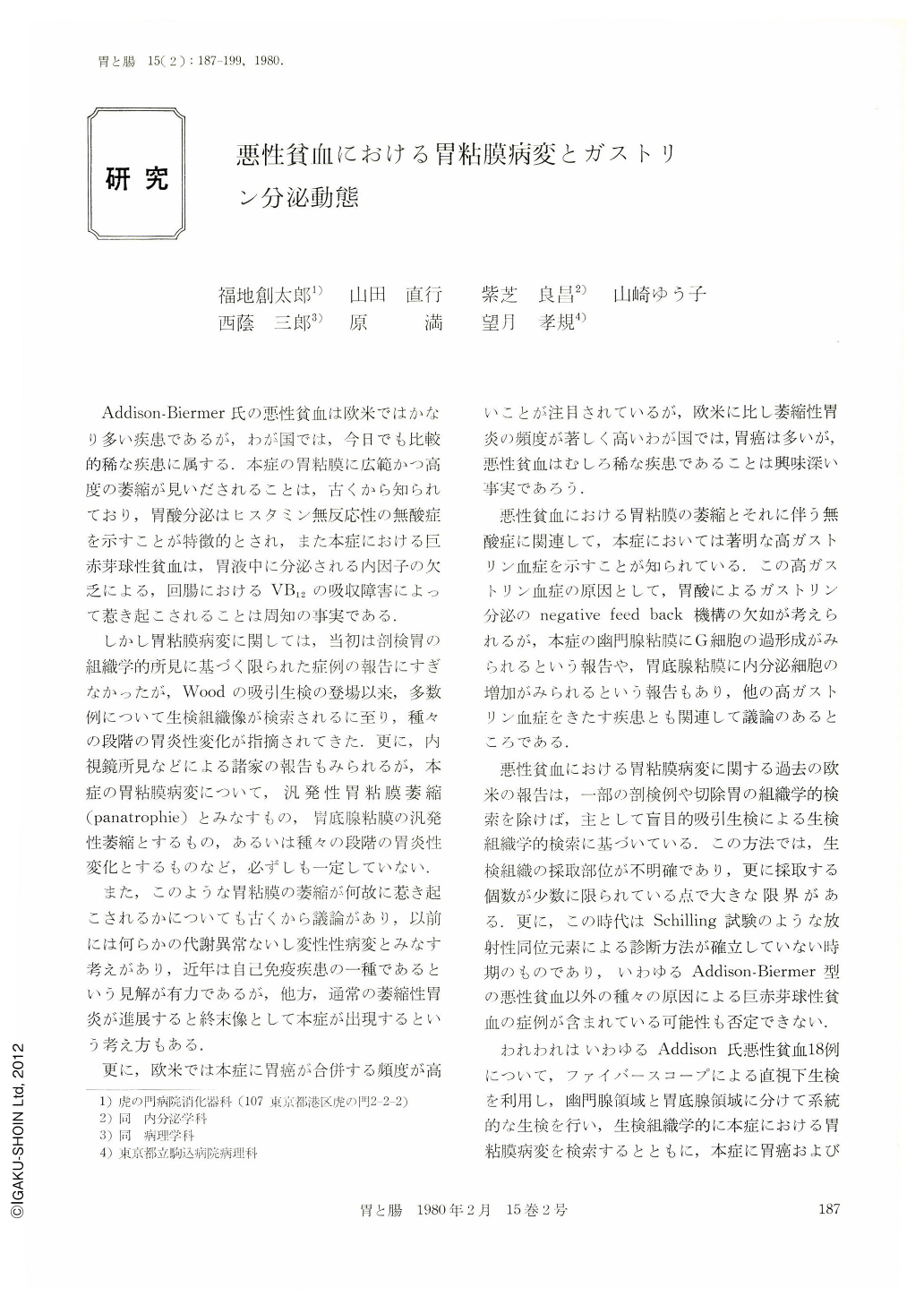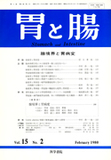Japanese
English
- 有料閲覧
- Abstract 文献概要
- 1ページ目 Look Inside
- サイト内被引用 Cited by
Addison-Biermer氏の悪性貧血は欧米ではかなり多い疾患であるが,わが国では,今日でも比較的稀な疾患に属する.本症の胃粘膜に広範かつ高度の萎縮が見いだされることは,古くから知られており,胃酸分泌はヒスタミン無反応性の無酸症を示すことが特徴的とされ,また本症における巨赤芽球性貧血は,胃液中に分泌される内因子の欠乏による,回腸におけるVB12の吸収障害によって惹き起こされることは周知の事実である.
しかし胃粘膜病変に関しては,当初は剖検胃の組織学的所見に基づく限られた症例の報告にすぎなかったが,Woodの吸引生検の登場以来,多数例について生検組織像が検索されるに至り,種々の段階の胃炎性変化が指摘されてきた.更に,内視鏡所見などによる諸家の報告もみられるが,本症の胃粘膜病変について,汎発性胃粘膜萎縮(panatrophie)とみなすもの,胃底腺粘膜の汎発性萎縮とするもの,あるいは種々の段階の胃炎性変化とするものなど,必ずしも一定していない.
In our 18 cases of pernicious anemia, histological investigation regarding gastric mucosal lesion was performed by endoscopic biopsies. Literature review was also done and our results were as follows;
1) A characteristic gastric lesion in pernicious anemia was a diffuse and marked atrophy of fundic mucosa showing almost complete disappearance of fundicglands and it was replaced by pyloric glands, pseudopyloric glands or intestinal rnetaplasia.
On the other hand, pyloric glands were relatively well preserved in majority of case but in some case antral mucosa was also accompanied by atrophic gastritis and showed pan-atrophic pattern seemingly which included gastric fundus.
2) This peculiar gastric lesion can not be understood merely as the ultimate outcome of ordinary atrophic gastritis.
3) According to the literature, the gastric lesion can not be improved even after normalization of blood picture by Vitamin B12 administration, and our study also confirmed this.
4) Along with the gastric lesion, achlorhydria is a essential clinical picture in pernicious anemia, and does not react to the endoscopic Congo-red method. Therefore, this is a very important tool to differentiate pernicious anemia from the secondary megaloblastic anemia.
5) Pernicious anemia complicated by gastric CA was found in 2 out of 18 our cases. This indicates that periodical check up of the gastric lesion is essential in pernicious anemia.
In pursuit of gastrin secretion in pernicious anemia, we performed systemic gastric biopsies in 4 cases and quantitated mucosal gastrin content by RIA method. We also evaluated distribution of gastrin producing cells in the stomach as well as electromicr0scopic examination. Results were as follows;
1) 2 out of 3 cases which had hypergastrinemia showed increased mucosal gastrin content in antral area but no G-cell hyperplasia was noted. Electron microscopic observation also showed increased secretory granules in the G-cell.
2) All 3 cases with hypergastrinemia showed gastrin secreting cell in the fundic area. and high gastrin level in the mucosa was also noted while normal mucosa had only a small amount.
Such phenomenon was also demonstrated in the body of the stomach where marked atrophic gastritis took place without pernicious anemia.
3) One case which had no elevation of fasting serum gastrin level showed marked atrophic antral gastritis, severely depleted G-cells and reduced mucosal gastrin in the antrum.

Copyright © 1980, Igaku-Shoin Ltd. All rights reserved.


